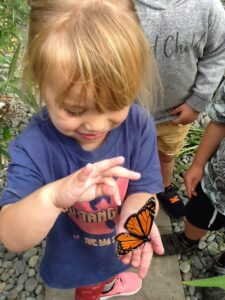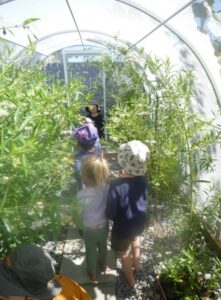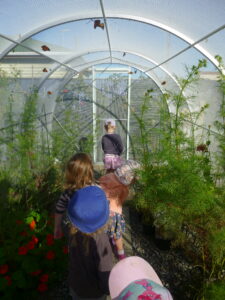
Learning how to be gentle.
Seymour Kindergarten’s new butterfly house has become a cherished space, with tamariki and kaiako benefiting from the opportunities it provides.
Identify
The different life stages of monarch butterflies have long been an area of fascination for tamariki at Seymour Kindergarten, and kaiako have supported their learning in a variety of ways over the years. After identifying what a struggle it was for these beautiful creatures to complete their lifecycle, they began exploring ways to give them a better chance at life.
Their noticings included the need for protection from predators – wasps, pray mantis and ants. An adequate supply of food – swan plants and other nectar flowers. And a place for butterflies to lay.
Explore
Tamariki explored different methods to overcome the identified challenges. Beginning with bringing all eggs and caterpillars inside and keeping them in an enclosed space and then releasing the butterfly once it had hatched. Whilst this eliminated the risk of predators it didn’t feel right to remove them from their natural habitat.
Action

Swan plant is a particularly successful caterpillar food.
A collective decision was soon made to construct an impressive butterfly house. This was surrounded by swan plants for laying and nectar flowers for feeding the butterflies.
However, this didn’t remove all the barriers for success. The challenge to find the best way to capture caterpillar eggs and transfer them to the safety of the butterfly house was now upon them. They tried taking eggs from the swan plants outside and raising them inside before transferring them. Sometimes this was successful, however, it took a lot of work as the leaves needed to be kept damp at all times. They tried waiting until the eggs hatched on the outside plants before transferring the newly hatched caterpillars into the house. Sometimes the predators got to them first! The most successful method has been to carefully capture the female butterfly and place her into the house so that she can lay directly onto the plants. Tamariki have loved this experience and can regularly be heard calling for a kaiako to capture a butterfly when they see one in the garden.
On one occasion tamariki came back from the weekend to release 32 butterflies!
Reflect

A mix of flower species provided a varied diet for the butterflies in their protected surroundings.
Whilst caring for their caterpillars, tamariki noticed that they liked to move along the side of the house and form their chrysalis hanging from the netting. While this seemed to be a great place for them, they discovered that paper wasps were able to attack them through the netting, so making wasp traps became another project. This had mixed results but took their learning in new directions as they learnt all about the different types of wasps and other predators, what they eat and whether they are good for our environment or not.
Visiting the house daily to check on the progress of the eggs and caterpillars quickly became a favourite activity for many. The butterfly house has become a very special space where tamariki can investigate the living world, broaden their interests and develop scientific thinking skills. Through collaborative learning, tamariki used problem-solving skills, which empowered them to share their knowledge and ideas with their peers. They also gained the skills to take responsibility in looking after living things enabling them to become successful lifelong learners.
Community and whānau support have been hugely appreciated with the donation of plants, eggs, caterpillars as well as time and energy spent in the gardens.